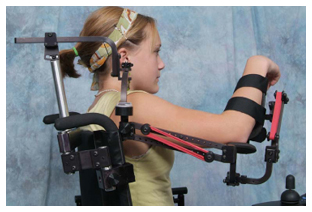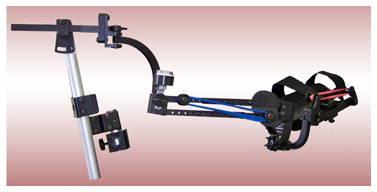|
Orthologix brings you quarterly information to keep you current on industry news, trends and insights. Orthologix is an orthotics and prosthetics practice delivering evidence-based care throughout the Delaware Valley.

Orthologix Opens Orthotic and Prosthetic Center of Excellence
 Orthologix has opened the first of its kind Orthotic and Prosthetic Center of Excellence in Bucks County, located at 2655 Interplex Drive, Suite 101 in Trevose, Pa. Orthologix has opened the first of its kind Orthotic and Prosthetic Center of Excellence in Bucks County, located at 2655 Interplex Drive, Suite 101 in Trevose, Pa.
The new facility houses Orthologix corporate headquarters as well as an education center, gait lab, and technology-linked patient care suites.
Back to top

FEATURED PRODUCT
Wilmington Robotic Exoskeleton (WREX)
 The Jaeco WREX (Wilmington Robotic Exoskeleton) is a functional upper limb orthosis designed to enhance movement for individuals with neuromuscular disabilities. Its state-of-the-art construction utilizes a lightweight exoskeleton that approximates normal human anatomy. Linear elastic bands are used both for balance and to assist movement in three dimensions against the effects of gravity. These features provide for exceptional range of motion to aid in a variety of therapeutic and daily living activities. The Jaeco WREX (Wilmington Robotic Exoskeleton) is a functional upper limb orthosis designed to enhance movement for individuals with neuromuscular disabilities. Its state-of-the-art construction utilizes a lightweight exoskeleton that approximates normal human anatomy. Linear elastic bands are used both for balance and to assist movement in three dimensions against the effects of gravity. These features provide for exceptional range of motion to aid in a variety of therapeutic and daily living activities.
Designed at A.I. DuPont Hospital for Children, the WREX is for patients with neuromuscular weakness such as muscle disease, cerebral palsy, spinal cord injury, multiple sclerosis and amyotrophic lateral sclerosis that effects upper limbs. It can also serve as a cost effective exercise/therapy device for people recovering from stroke.
The WREX can be attached to most common wheelchairs and mobility seating systems utilizing one of the three Mount Bases provided with the arm. These are the same attachment systems that are the basis of JAECO's Mount Relocator. The WREX can be assembled as left or right. The size is adjustable to fit most children through adult arms.
Tariq Rahman, director of the Center for Orthopedic Research and Development (CORD) at the Alfred I. DuPont Hospital for Children and Head of the Pediatric Engineering Laboratory, has published extensively in the area of rehabilitation engineering on issues relating to tremor reduction, robotics, orthotics, and orthopedics. He was the lead researcher in several studies on the effectiveness of the WREX. Below are abstracts and links to three of them:
Back to top

CASE STUDIES
"Passive Exoskeletons for Assisting Limb Movement"
Journal of Rehabilitation Research & Development, August/September 2006
This article presents the state of the art in passive devices for enhancing limb movement in people with neuro-muscular disabilities. Both upper- and lower-limb projects and devices are described. Special emphasis is placed on a passive functional upper-limb orthosis called the Wilmington Robotic Exoskeleton (WREX). The development and testing of the WREX with children with limited arm strength are described. The exoskeleton has two links and four degrees of freedom. It uses linear elastic elements that balance the effects of gravity in three dimensions. The experiences of five children with arthrogryposis who used the WREX are described.
To read the study visit: www.rehab.research.va.gov/jour/06/43/5/pdf/rahman.pdf
"Design and Testing of a Functional Arm Orthosis in Patients with Neuromuscular Diseases"
IEEE Transactions on Neural Systems and Rehabilitation Engineering, Vol. 15, No. 2, June 2007
 The objective of this study was to determine the utility of a passive gravity-balanced arm orthosis, the Wilmington Robotic Exoskeleton (WREX) for patients with neuromuscular diseases. The development and clinical testing of WREX is described in this report. Seventeen patients (14 boys and 3 girls) with muscular disabilities participated in the study. Ages ranged from 4 to 20 years. Criteria for inclusion included a weakened arm, use of a wheelchair, the ability to grasp and release objects, and the ability to provide feedback on device use. Testing consisted of administering the Jebsen test of hand function without WREX and then testing again after approximately two weeks of wearing the WREX orthosis. The timed results of each task within the test then were compared. Specific tasks related to vertical movement required less time to perform with the WREX. A large number of subjects were able to perform the Jebsen tasks with WREX, where they were unable to perform the task without the WREX. Patients can benefit from WREX because it increases their performance in daily living activities and makes many tasks possible. The range-of-motion in the patients' arms increased considerably, while the time required to complete some of the Jebsen test tasks decreased. Most patients were very receptive to WREX, although a few were ambivalent.
To read the study visit: http://idea.library.drexel.edu/handle/1860/2032 The objective of this study was to determine the utility of a passive gravity-balanced arm orthosis, the Wilmington Robotic Exoskeleton (WREX) for patients with neuromuscular diseases. The development and clinical testing of WREX is described in this report. Seventeen patients (14 boys and 3 girls) with muscular disabilities participated in the study. Ages ranged from 4 to 20 years. Criteria for inclusion included a weakened arm, use of a wheelchair, the ability to grasp and release objects, and the ability to provide feedback on device use. Testing consisted of administering the Jebsen test of hand function without WREX and then testing again after approximately two weeks of wearing the WREX orthosis. The timed results of each task within the test then were compared. Specific tasks related to vertical movement required less time to perform with the WREX. A large number of subjects were able to perform the Jebsen tasks with WREX, where they were unable to perform the task without the WREX. Patients can benefit from WREX because it increases their performance in daily living activities and makes many tasks possible. The range-of-motion in the patients' arms increased considerably, while the time required to complete some of the Jebsen test tasks decreased. Most patients were very receptive to WREX, although a few were ambivalent.
To read the study visit: http://idea.library.drexel.edu/handle/1860/2032
"A Body-Powered Functional Upper Limb Orthosis"
Journal of Rehabilitation Research and Development Vol. 37, No. 6, November/December 2000
This paper describes the development and preliminary testing of a functional upper-limb orthosis for people that have limited strength in their arms. This is symptomatic of conditions such as muscular dystrophy (MD), spinal muscular atrophy (SMA), and partial spinal cord injury. The exoskeletal orthosis is wheelchair mounted, has two links and four degrees of freedom. It uses linear elastic elements to balance out the effects of gravity in three dimensions. Preliminary results on testing with 10 subjects will be presented. To read the study visit: http://www.rehab.research.va.gov/jour/00/37/6/pdf/rahman.pdf

PROFILE
Kacy Moran Powers, CO
 When she was a mechanical engineering student at Villanova University, Orthologix practitioner Kacy Moran Powers, CO, worked on helping with the development of the Wilmington Robotic Exoskeleton (WREX) during an internship in the Biomedical Engineering Research Department at Nemours/Alfred I DuPont Hospital for Children. She remained at Nemours for five years and co-authored a published article about the WREX, "Design and Testing of a Functional Arm Orthosis in Patients with Neuromuscular Diseases," found in the case study section of this newsletter. She also has experience with the Wilmington Scoliosis System. Powers also is a graduate from the certificate program at the Northwestern University Prosthetic-Orthotic Center (NUPOC), Chicago. She intends to continue her studies to complete her prosthetics certification. When she was a mechanical engineering student at Villanova University, Orthologix practitioner Kacy Moran Powers, CO, worked on helping with the development of the Wilmington Robotic Exoskeleton (WREX) during an internship in the Biomedical Engineering Research Department at Nemours/Alfred I DuPont Hospital for Children. She remained at Nemours for five years and co-authored a published article about the WREX, "Design and Testing of a Functional Arm Orthosis in Patients with Neuromuscular Diseases," found in the case study section of this newsletter. She also has experience with the Wilmington Scoliosis System. Powers also is a graduate from the certificate program at the Northwestern University Prosthetic-Orthotic Center (NUPOC), Chicago. She intends to continue her studies to complete her prosthetics certification.
Back to top

"HHS Announces Proposed Changes to HIPAA Privacy Ruler"
HITECH lets people know who has accessed their health information
A Notice of Proposed Rulemaking concerning the accounting of disclosures requirement under the Health Insurance Portability and Accountability Act (HIPAA) Privacy Rule, is available for public comment. The proposed rule would give people the right to get a report on who has electronically accessed their protected health information.
The U.S. Department of Health and Human Services' (HHS) Office for Civil Rights (OCR) is proposing changes to the Privacy Rule, pursuant to the Health Information Technology for Economic and Clinical Health (HITECH) Act. HITECH is part of the American Recovery and Reinvestment Act of 2009.
"This proposed rule represents an important step in our continued efforts to promote accountability across the health care system, ensuring that providers properly safeguard private health information," said OCR Director Georgina Verdugo. "We need to protect peoples' rights so that they know how their health information has been used or disclosed."
People would obtain this information by requesting an access report, which would document the particular persons who electronically accessed and viewed their protected health information. Although covered entities are currently required by the HIPAA Security Rule to track access to electronic protected health information, they are not required to share this information with people.
The proposed rule requires an accounting of more detailed information for certain disclosures that are most likely to affect a person's rights or interests. The proposed changes to the accounting requirements provide information of value to individuals while placing a reasonable burden on covered entities and business associates.
People may now read the proposed rule at: http://www.federalregister.gov/and submit comments to http://www.regulations.gov/ (search for Proposed Rule) through August 1, 2011.
People who believe a covered entity has violated their (or someone else's) health information privacy rights or committed another violation of the HIPAA Privacy or Security Rules, may file a complaint with OCR at http://www.hhs.gov/ocr/privacy/hipaa/complaints/index.html. Additional information about OCR's enforcement activities can be found at: http://www.hhs.gov/ocr
Back to top

Q & A
Please feel free to submit your questions on the WREX as well as any other issue you would like addressed.

Back to top

Educational Workshops and Inservices
Orthologix is available to present educational workshops and inservices for your group or your facility. Email us at info@orthologix.com to schedule.

We hope you have found this issue of the Orthologix E-news informative.
Thank you for your subscription.
Back to top
|
